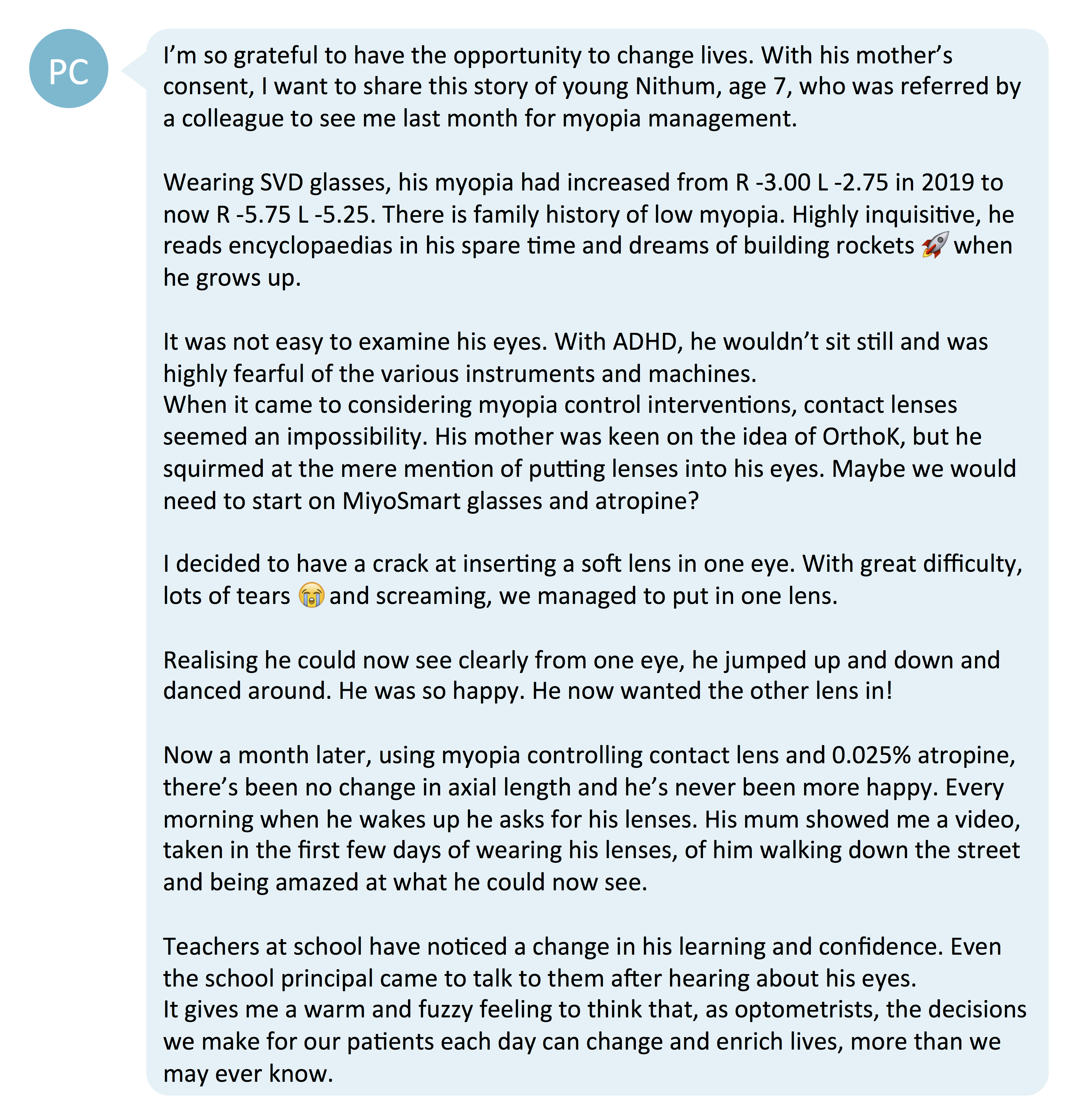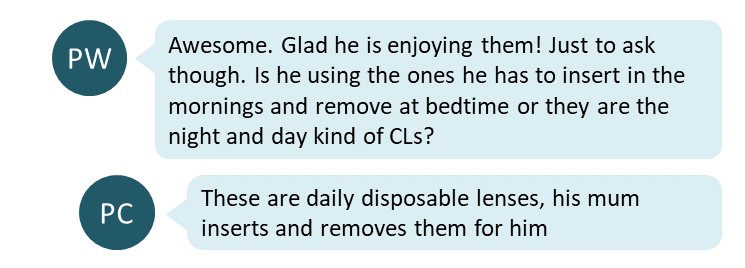Can an anxious child cope with contact lens forms of myopia management? The answer is YES. Here is an inspiring case study about myopia management for a child with ADHD whose cooperation was hard won, through caring clinical efforts. Here are the details.

Contact lens myopia management options offer the benefit of slowing myopia progression as well as the boost in confidence which typically comes with childhood contact lens wear.1 However, contact lenses may not seem a viable option for anxious children who seem unlikely to be able to handle them.
“There are many things that seem impossible only so long as one does not attempt them” said French author André Gide, winner of the Nobel Prize in literature in 1947.
In this case, PC successfully managed to apply a contact lens for this child in-office, and this opened the window to successfully using contact lenses as part of the myopia control strategy. There were added benefits of contact lenses affecting a positive impact on this child's learning and personal confidence.
Contact lens handling options

In this case, various myopia management options were discussed, from spectacles to atropine to orthokeratology and soft myopia controlling contact lenses. Whilst the comfort and adaptation to soft contact lenses versus orthokeratology have not been directly compared, there is likely to be less foreign body sensation with soft contact lenses2 - at least in the short daily period of orthokeratology wear before the eyes are closed overnight.
If the child is unable to apply and remove contact lenses themselves, their parent or guardian may do so for them, as is the case for this patient. There is no data on how parental lens handling may influence comfort or acceptance. One study of compliance in orthokeratology showed that children who were undertaking all aspects of lens handling and care themselves were slightly less compliant than when their parents were undertaking lens handling. This reinforces the importance of discussing lens handling and care steps with parents and children at each instance of clinical care.3
The clinical approach with anxious children
There is a dilemma in deciding on myopia management strategies for children who are anxious about myopia management options perceived to be ‘invasive’ (such as contact lenses or atropine drops) when their parents are otherwise supportive and motivated. It can be a challenge to demonstrate to the child that ‘it is not as bad as they think’ by balancing proactivity with sensitivity to avoid upsetting them.
Lerwick offers a useful tool in helping a clinician minimize fear and anxiety for children in a healthcare setting using CARE principles.4
- C – Choices: Offering power to a child by helping them understand the process and giving them an ability to express a choice can help reduce their propensity for anxiety. An example would be "would you like me to put this contact lens on your right eye or left eye first?"
- A – Agenda: Explaining the process of what is going to happen can help to reduce fear. An example of this is in this context is explaining to the child how the contact lens might feel on the eye, such as that they may expect a cold or wet sensation, which is normal.
- R – Resilience: Identifying a patient’s strengths and framing conversation with positive language help build trust and rapport.
- E – Emotions: It is common for children to face the unknown with many emotions such as fear or anxiety. Normalizing these emotions and empathizing with them will help them feel understood and validated and calm their fears.
Applying a contact lens for an anxious child is no easy feat. Ultimately, children are the end users, so it is important to work with them as persons with autonomy. Patience is a virtue in such circumstances and perseverance can make the impossible possible.
Take home messages:
- Contact lens fitting for anxious children may seem impossible, however it can be done with trial fitting and patience.
- Parents play a very important role in guiding their children on their contact lens journey to increase likelihood of success, including support with handling as required.
Further reading on kids, contact lenses and communication

About Kimberley
Kimberley Ngu is a clinical optometrist from Perth, Australia, with experience in patient education programs, having practiced in both Australia and Singapore.

About Connie
Connie Gan is a clinical optometrist from Kedah, Malaysia, who provides comprehensive vision care for children and runs the myopia management service in her clinical practice.
This content is brought to you thanks to an unrestricted educational grant from
![]()
References
- Walline JJ, Gaume A, Jones LA, Rah MJ, Manny RE, Berntsen DA, Chitkara M, Kim A, Quinn N. Benefits of contact lens wear for children and teens. Eye Contact Lens. 2007;33(6 Pt 1):317-321. (link)
- Jones-Jordan LA, Walline JJ, Mutti DO, Rah MJ, Nichols KK, Nichols JJ, Zadnik K. Gas permeable and soft contact lens wear in children. Optom Vis Sci. 2010 Jun;87(6):414-20. (link)
- Jun J, Zhiwen B, Feifu W, Lili L, Fan L. Level of Compliance in Orthokeratology. Eye Contact Lens. 2018 Sep;44(5):330-334. (link)
- Lerwick JL. Minimizing pediatric healthcare-induced anxiety and trauma. World journal of clinical pediatrics. 2016 May 8;5(2):143. (link)











